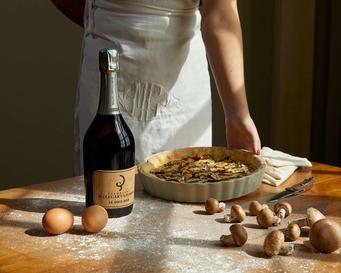

Words: Gentleman's Journal
When it comes to constructing an edifice, Britain reigns supreme. From the splendour of Windsor Castle to the heights of Big Ben, there’s a jewel box of architectural goods that spreads far and wide across Blighty. But if you’re the type of gent who’s tired of viewing the same old guide-book-friendly sites, then look no further, for below are the finest pieces of British architecture that will forever entice visitors and photographers with their striking and groundbreaking aesthetics.
Beetham Tower, Manchester
From within Manchester’s relatively low-line cityscape shoots out the gargantuan Beetham Tower – a 48-storey, 554-foot-tall behemoth of a skyscraper that’s come to symbolise the northern capital’s growth, development and reinvention during the post-industrial epoch.
Once billed as the “United Kingdom’s only proper skyscraper outside London” and completed by Simpsonhaugh and Partners in 2006, the tower is located on a tiny sliver of land in the crowded Deansgate area, hence its incredibly elongated form – in fact, with a height to width ratio of 10:1, it currently stands as one of the thinnest landmarks in the world.
Notable specs include a 13 foot cantilever on the 23rd floor – a feature designed to increase floor space and give the building some bulk and definition – and mismatched lines which add a sense of movement. To date, the tower boasts a 4-star Hilton hotel, luxury apartments, a sky bar and – on a clear day – vistas of Snowdonia and the Irish sea.
So, if you’re considering a city break in this northern hub, you know exactly where to go in order to peruse some unique panoramas while sipping on an Old Fashioned.
The Barbican, London
In London, prodigious constructions reign supreme. Some are sharp and worldly (The Shard), others are unsightly (The Walkie Talkie). But what visitors (and even residents) often fail to do is to peel their eyes away from the skies and concentrate on things closer to ground. The finest thing to look out for when traversing the streets of the Old Smoke? The Barbican: a vast, concrete estate that comprises 2,000 flats and a leading arts complex, and is perhaps one of the few locations in the capital that’s widely known, but not overrun by travellers and tourists with iPads in hand.
A prime example of brutalist architecture, the Barbican was erected on a vast bomb site that was abandoned after the Second World War and it began opening in stages between 1969 and 1982. Today, it plays host to two theatres, two art galleries, a concert hall and a library – all of which are highly regarded amongst London’s cultural cognoscenti.
For a respite, the on-site café is also a good spot to perch, as is any lakeside bench – here you can study and scrutinise the symmetrical curves and straight lines of the sought-after Barbican living spaces. But the best thing to check out is, without doubt, the Conservatory. Inside you’ll find unfurling and undulating strands of greenery and trees which harmonise beautifully to create London’s finest indoor oasis.
The Royal Pavilion, Brighton & Hove
Designed by John Nash and originally made as a seaside pleasure palace for King George IV, the Royal Pavilion, with its Indo-Saracenic-style architecture, is one the more unique pieces of architecture within the UK.
It was once a simple farmhouse, but by 1818 it had been unveiled as one of Europe’s most opulent residential buildings, with grand domes and minarets aplenty. When you step foot inside the place you’ll find Oriental-inspired furnishings and colours, decorations loaned from the Queen, a music room with a ceiling of 26,000 gold scales and a dragon-themed banqueting hall.
V&A Museum of Design, Dundee
Thanks to the growing stature of the Duncan of Jordanstone College of Art and Design at the city’s eponymous university, Dundee has rapidly become a hive for great art – a notion which will be solidified later this year with the opening of the highly-awaited V&A Museum of Design.
Although the ribbons may not have been cut on the doors just yet, it’s already obvious that Dundee’s V&A is a striking and potent landmark. The international competition that was set up to find a designer for this building was won by Kengo Kuma, and as one the most prominent starchitects in the world, he’s made sure that his first ever work in the UK will be the magnum opus in Dundee’s £1bn waterfront transformation.
From what has been revealed, there are three-storeys with curving concrete walls, 21 separate wall sections and 2,466 cast stone panels which are placed on the outer walls – a feature which will make the gallery’s exterior appear like a dramatic Scottish cliff face.
Set to open in the middle of this year, the V&A will showcase Scottish designers, both past and contemporary, including Charles Rennie Mackintosh, as well as fashion creatives such as Holly Fulton.
Radcliffe Camera, Oxford
When it comes to producing timeless and historic architecture, Oxford is a golden goose. Christ Church college is one of Sir Christopher Wren’s finest products and has inspired sets for many of the films in the Harry Potter franchise; the Divinity School is a photographer’s dream thanks to its learn vaults and star-shaped patterned ceiling; and the Ashmolean is one of the standout neoclassical buildings in the country. But despite this plethora of edifices, it’s the Radcliffe Camera (or Rad Cam as known by students) that shines brightest.
Located in the heart of the city, and dominating the charming cobbles of Radcliffe Square, this circular library, which was built between 1737 and 1749, is one of the most picturesque constructions you’ll find anywhere. Why? Because whether it’s the beautifully symmetrical, sandy-coloured exterior and well-manicured lawn, or the light-filled, columned library and reading room, every inch of this English Palladian-style beauty is idyllic and perfectly-formed.
Need more monuments? These are the 10 architectural masterpieces everyone should see in their lifetime


